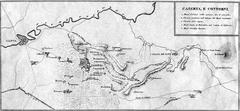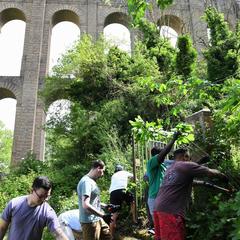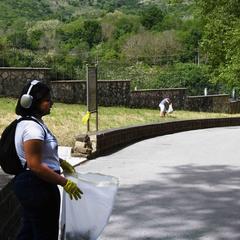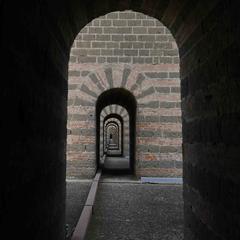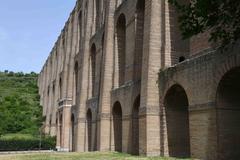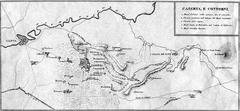
Aqueduct of Vanvitelli: Visiting Hours, Tickets, and Historical Significance in Caserta
Date: 14/06/2025
Introduction
The Aqueduct of Vanvitelli, or Acquedotto Carolino, is an enduring 18th-century marvel of hydraulic engineering and architecture located in Caserta, southern Italy. Designed by Luigi Vanvitelli for Charles VII of Naples, it was conceived to supply water to the Royal Palace of Caserta, its gardens, the San Leucio silk complex, and the surrounding city. Spanning approximately 38 kilometers from the Fizzo springs near the Taburno mountains, the aqueduct’s route reflects both technical precision and artistic grandeur. Its most iconic feature, the three-tiered bridge crossing the Valle di Maddaloni, remains a testament to Enlightenment ideals and Bourbon ambition. Today, the aqueduct is a UNESCO World Heritage Site, drawing visitors from around the world and offering a unique insight into Italy’s rich cultural and technological legacy (UNESCO; Visit Naples; Spotting History).
Table of Contents
- Introduction
- Historical Context and Purpose
- Architectural and Engineering Features
- Social and Cultural Significance
- Visiting Information
- Travel Tips
- Nearby Attractions
- Conservation and Legacy
- Frequently Asked Questions (FAQ)
- Conclusion
- References
Historical Context and Purpose
Commissioned in 1753 by Charles VII of Naples (later Charles III of Spain), the Aqueduct of Vanvitelli was designed to address the water demands of the newly constructed Royal Palace of Caserta, its elaborate gardens, and the growing industrial and urban needs of the region (UNESCO). Luigi Vanvitelli, inspired by ancient Roman aqueducts, engineered a system capable of supporting monumental fountains, agricultural irrigation, and the silk manufacturing complex at San Leucio. Construction began in 1753 and concluded in 1762, marking a significant step in the modernization of the Campania region (Ministero della Cultura).
Architectural and Engineering Features
Route and Structure
The aqueduct starts at the Fizzo springs in Bucciano, chosen for their purity and reliability. Most of its 38-kilometer length runs underground to protect water quality and reduce evaporation, using stone and brick channels with precisely calculated gradients (Spotting History). The most celebrated segment is the Valle di Maddaloni bridge—529 meters long and 55.8 meters high, featuring 67 arches in three tiers. This visually striking structure, inspired by the Pont du Gard and Roman designs, utilizes local tufa stone for resilience and earthquake resistance (Visit Naples).
Engineering Innovations
- Hydraulic Precision: The aqueduct maintains a gradient of just 0.5 meters per kilometer, ensuring a continuous gravity-fed water flow that avoids both stagnation and erosion (Enciclopedia Treccani).
- Materials: Tufa stone and brick were chosen for their structural properties, especially in earthquake-prone Campania, and arches were designed with a square plan for optimal load distribution.
- Maintenance: The aqueduct includes inspection shafts and sluice gates, facilitating operations and repairs—a practice inherited from Roman engineering.
Social and Cultural Significance
The Aqueduct of Vanvitelli was pivotal in transforming Caserta into a modern city. It:
- Supplied water to royal gardens, fountains, and the San Leucio silk industry.
- Enabled agricultural development and improved public health.
- Supported local industries and created jobs during and after construction (Ministero della Cultura).
- Became a symbol of Enlightenment ideals, fusing technological innovation with public utility (UNESCO).
The aqueduct’s iconic design and historical resonance have made it a source of local pride, featured in festivals, educational programs, and artistic works (Italian Notes).
Visiting Information
Hours and Tickets
- Visiting Hours: The aqueduct and its outdoor sections (notably the Valle di Maddaloni bridge) are accessible year-round, typically from 9:00 AM to 6:00 PM. Hours may vary seasonally; check with local visitor centers for updates (The Tourist Checklist).
- Tickets: Access to the Valle di Maddaloni bridge and public pathways is free. Tickets are required for the Royal Palace of Caserta and its gardens (about €12 for adults, discounts for students and free entry for children under 18). Combined tickets with San Leucio are available (Spotting History).
Accessibility
- Some sections, especially around the Maddaloni bridge, are accessible via paved paths with parking nearby.
- The Royal Palace and gardens offer wheelchair access, but some aqueduct trails may be uneven or unpaved.
- For visitors with mobility issues, it is advisable to contact local tourist offices before your visit.
How to Get There
- By Car: The Valle di Maddaloni bridge is about 7 km from Caserta; follow SP335.
- By Public Transport: Local buses connect Caserta with Maddaloni, and the aqueduct is within walking distance from Maddaloni town center.
Guided Tours
- While no official tours focus solely on the aqueduct, local agencies and Caserta tourism offices offer self-guided maps and combined tours with the Royal Palace and San Leucio complex.
- Occasional special events and educational programs are held at or near the aqueduct.
Travel Tips
- Best Time to Visit: Late spring and early autumn offer pleasant weather and fewer crowds.
- Photography: The Valle di Maddaloni bridge is a stunning spot for sunrise or sunset images.
- Footwear: Comfortable shoes are recommended for exploring uneven paths.
- Local Experiences: Enhance your visit with local dining in Maddaloni or Caserta.
Nearby Attractions
- Royal Palace of Caserta: A UNESCO World Heritage Site, renowned for its architecture and gardens.
- San Leucio Complex: Historic silk factory and model industrial community.
- Belvedere of San Leucio: Offers panoramic views of the aqueduct and valley.
- Maddaloni Town: Charming streets, local culture, and access to the aqueduct.
Conservation and Legacy
The aqueduct is actively preserved under Italian heritage law, with ongoing restoration to address water infiltration and seismic risks (Ministero della Cultura). Its UNESCO World Heritage status underscores its universal value, ensuring international attention and support for its long-term protection (UNESCO).
Frequently Asked Questions (FAQ)
Q: What are the visiting hours of the Aqueduct of Vanvitelli?
A: Outdoor sections are generally accessible from 9:00 AM to 6:00 PM, though hours may vary; verify before your visit.
Q: Is there an entrance fee?
A: Public viewing areas are free; tickets are required for the Royal Palace and gardens.
Q: How can I reach the aqueduct?
A: By car via SP335 or by local bus from Caserta to Maddaloni.
Q: Are guided tours available?
A: Self-guided maps and combined tours with other Caserta sites are available through local agencies.
Q: Is the site accessible for people with disabilities?
A: Some paths are paved and accessible, but certain areas may be challenging; check in advance.
Conclusion
The Aqueduct of Vanvitelli stands as a masterpiece of 18th-century engineering, reflecting the era’s blend of functionality, artistry, and social progress. From its meticulously engineered gravity-fed system to its majestic arches at Valle di Maddaloni, the aqueduct continues to inspire and serve the region as both a historical monument and a living part of the landscape. Whether you are drawn by its technical brilliance, its cultural legacy, or its scenic beauty, a visit to the Aqueduct of Vanvitelli is an essential experience for anyone exploring Caserta and southern Italy.
Plan your visit by checking current hours, ticketing options, and accessibility information. For detailed guides, navigation, and audio tours, download the Audiala app and follow local tourism channels for the latest updates.
References
- Aqueduct of Vanvitelli, UNESCO World Heritage Centre
- The Caroline Aqueduct in Campania, Visit Naples
- Aqueduct of Vanvitelli, Spotting History
- Acquedotto Carolino, Ministero della Cultura
- Aqueduct of Vanvitelli, Enciclopedia Treccani
- Visiting the Royal Palace of Caserta and Aqueduct of Vanvitelli, The Tourist Checklist
